Home Decor
Interior Decor Mistakes You’re Making and How to Fix Them!
Learn about common interior decor mistakes and discover simple fixes that can transform your space into a cozy reflection of your personality.
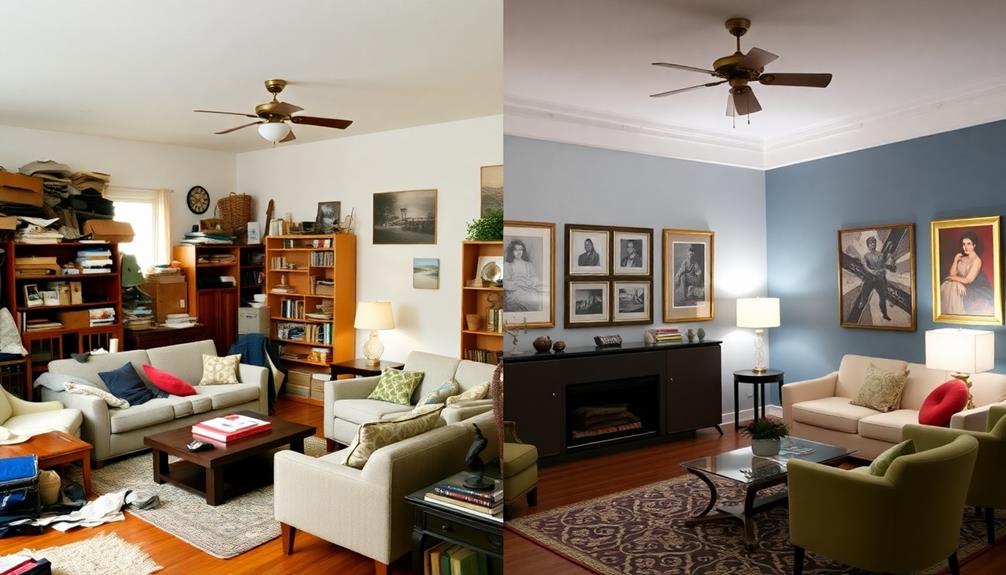
You might be making common interior decor mistakes that hold your space back. Consider your furniture arrangement; pulling everything against the walls feels cramped. Angle sofas and chairs for better flow. Next, don't just rely on overhead lighting; layer your lighting with ambient and task options for a cozy vibe. Check your rug sizes too; rugs should extend at least 60cm beyond your furniture for balance. Finally, make sure to mix colors and incorporate personal touches to make your space feel inviting. With a few tweaks, you can create a home that truly reflects your personality. There's more to explore!
Key Takeaways
- Avoid pushing furniture against walls; float pieces to enhance space flow and create a more inviting atmosphere.
- Incorporate layered lighting with ambient, task, and accent sources to eliminate harsh shadows and improve ambiance.
- Choose appropriately sized rugs that allow front legs of furniture to rest on them for a cohesive look and better comfort.
- Hang artwork at eye level and choose larger pieces for impactful displays, avoiding scattering items across walls.
- Personalize your space with unique items and cherished mementos to create warmth and reflect your individual style.
Furniture Arrangement Issues

When arranging furniture, you might be tempted to push everything against the walls, but this can make your space feel cramped and awkward. Instead, think about floating your furniture to improve flow and dimension. This common design mistake can hinder the room's functionality.
To create a more serene atmosphere, consider using natural materials and earth tones, which are key elements in Balinese interior design. Verify you maintain at least 80cm of space behind furniture to allow for easy movement.
Consider creating a balanced layout by positioning sofas and armchairs at angles, which promotes zoning and encourages conversation. Avoid cluttering the center space with excessive empty areas; a well-thought-out arrangement enhances both the functionality and aesthetic appeal of your room.
Pay attention to traffic patterns when planning your functional layout. By considering how people move through the space, you can create an inviting environment that's easy to navigate.
A thoughtful furniture arrangement not only improves flow but also contributes to the overall usability of the area. Remember, the goal is to create a space that feels open and welcoming, rather than boxed in.
Inadequate Lighting Choices

Inadequate lighting choices can greatly impact the mood and functionality of your space. Relying solely on overhead lighting often creates harsh shadows, making your rooms feel uninviting.
To enhance the ambiance, especially in homes inspired by tropical villa plans, you need to incorporate a mix of lighting types. Here are three key strategies to improve your lighting:
- Layered Lighting: Use a combination of ambient, task, and accent lighting. Table lamps, floor lamps, and sconces add warmth and depth to your rooms.
- Dimmer Switches: Installing dimmer switches allows you to adjust brightness levels for different occasions. Whether you're hosting a dinner party or enjoying a quiet evening, you can set the perfect mood.
- Soft White Bulbs: Choose soft white bulbs for a cozy environment. They emit a warm light that promotes relaxation and comfort.
Regularly evaluating and updating your lighting fixtures is essential.
Wrong Rug Sizes

Using a rug that's too small can make your room feel incomplete and disrupt its overall flow.
In a traditional Indonesian style home decor, for instance, the right rug can complement intricate carvings and textiles, enhancing the aesthetic appeal.
To create a cohesive look, make sure at least the front legs of your furniture rest on the rug.
Choosing the right size can't only enhance the room's design but also improve its comfort and functionality, especially when incorporating elements like natural materials to create a harmonious atmosphere.
Impact of Small Rugs
Although small rugs may seem like a quick solution for styling a room, they often create a disjointed feel that detracts from the overall design. Instead of enhancing your space, these small rugs can leave it looking incomplete, as they typically float rather than anchor furniture.
A well-chosen rug can drastically improve the balance and visual appeal of your room, contributing to a cozy atmosphere reminiscent of Scandinavian charm in kid-friendly homes.
To achieve a more cohesive environment, consider these tips:
- Choose rugs that allow at least the front legs of your furniture to rest on them.
- For beds, select rugs that extend at least 60cm beyond each side to connect the bedding with the floor.
- Opt for appropriately sized rugs to unify different areas, making your space feel larger and more inviting.
Investing in a correctly sized rug is essential for enhancing both the functionality and design of your room.
When you anchor furniture with appropriately sized rugs, you create a balanced look that elevates your interior decor.
Choosing Appropriate Rug Sizes
Choosing the right rug size can transform your space, while the wrong one can leave it feeling awkward and disjointed. One of the most common interior design mistakes is choosing a rug that's too small. Small rugs tend to float in the room, disrupting the overall cohesion.
To create a space that feels connected, make sure at least the front legs of your furniture rest on the rug. This unifies the look and enhances your room's aesthetic. Incorporating elements like Indonesian decorative pillows can also complement your rug choice, adding vibrant colors and intricate patterns that enhance the overall design.
For bedrooms, aim for a rug that extends at least 60cm beyond each side of the bed. This not only provides comfort but also creates a visually appealing border that ties the room together.
On the other hand, larger rugs can give the illusion of a larger space, making it feel more inviting and cozy.
When choosing appropriate rug sizes, keep scale and proportion in mind. Avoid overcrowding your room with multiple small rugs; instead, invest in one well-sized rug that enhances both design and functionality.
Artwork Misplacement
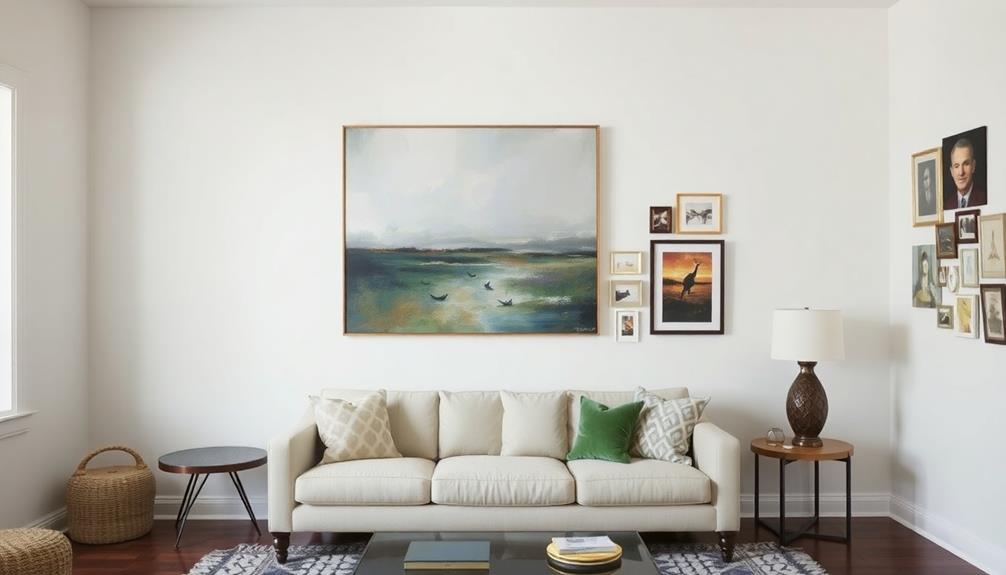
When it comes to displaying artwork, many people unknowingly make common missteps that can detract from a room's overall appeal. One major issue is artwork misplacement, which disrupts the visual balance of your space. Ideally, you should hang art at eye level to guarantee it has the maximum impact.
Incorporating elements of coastal color palettes can also enhance the overall aesthetic when choosing artwork. Here are some key points to reflect on:
- When placing art above furniture, aim for it to be about 2/3 the width of the piece below to create a cohesive vignette.
- On large walls, avoid scattering small art pieces; instead, opt for larger works or group smaller pieces to form a more striking display.
- Minimize gaps between furniture and art; mindful placement enhances integration and overall visual appeal.
Color Palette Missteps
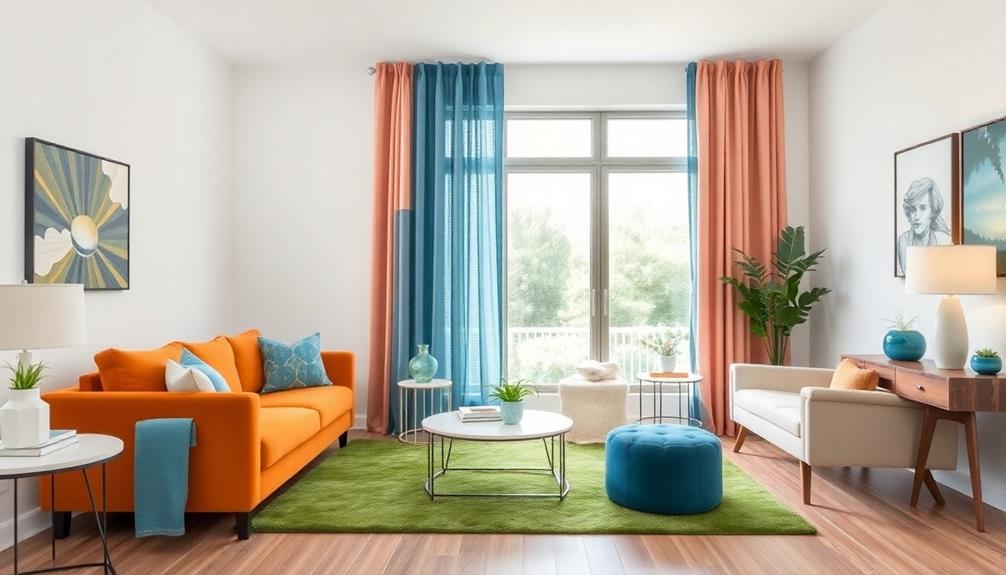
Many homeowners make the mistake of sticking to just one accent color, which can leave a space feeling flat and uninspired. To create a vibrant atmosphere, mix warm and cool tones within your color palette.
For inspiration, consider exploring expert tropical design that emphasizes functionality alongside aesthetic appeal. A cohesive color scheme should include 4-5 complementary colors, avoiding overly uniform setups that lack depth and character. This approach enhances visual interest and prevents your decor from feeling monotonous.
Incorporating multiple shades of a single hue can add dimension and richness to your space. For instance, if you choose a neutral color palette, introduce warmth with contrasting shades like sand, beige, and camel. This strategy prevents a cold, stark atmosphere while enhancing sophistication.
Don't forget to test your paint colors at various times of day. Lighting can dramatically alter how colors appear, influencing the mood of your room.
Lack of Personal Touches
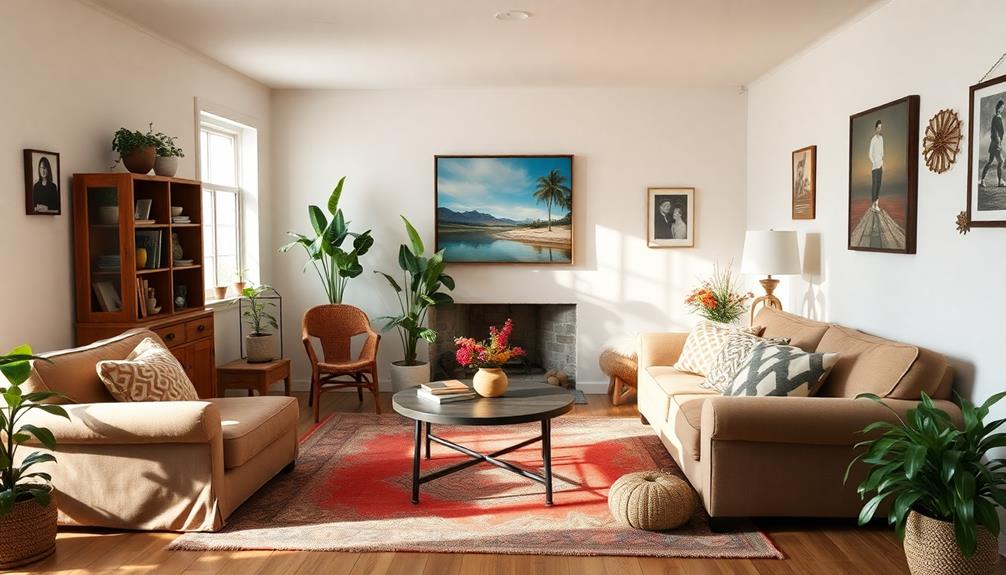
When you skip personal touches in your decor, your space can feel cold and uninspired.
Incorporating unique items, such as an Indonesian decor mask with its rich cultural heritage, not only warms up your home but also reflects your personality and experiences.
Embracing personalization helps create an inviting atmosphere that truly feels like yours.
Importance of Personalization
Incorporating personal touches into your decor is essential for creating a warm and inviting atmosphere that reflects who you are. Without these elements, your space can feel sterile and impersonal, missing the character that makes it truly yours.
To enhance your decor, consider adding unique pieces like traditional artistry from Indonesian decor masks that tell stories and celebrate local culture.
Avoid these common pitfalls to enhance your home's authenticity and emotional connections:
- Display meaningful items: Incorporate family heirlooms or travel souvenirs that tell your story and foster a sense of belonging.
- Balance curated decor with personal artifacts: A mix of original pieces and curated items creates a cohesive narrative, making your space visually appealing and comfortably lived-in.
- Skip generic art: Ditch clichéd quotes and opt for unique pieces that resonate personally with you, adding depth and authenticity to your design.
Choosing Meaningful Art
Choosing Meaningful Art (Lack of Personal Touches)
Art is an essential component of your home's personality, and choosing pieces that resonate with you can transform your space from bland to inviting. When you select art with personal significance, you create an environment that reflects your story and evokes memories or emotions.
Incorporating culturally rich elements, such as Indonesian decor masks, can add depth and storytelling to your decor. Avoid clichéd prints or generic quotes that don't connect with you. Instead, focus on meaningful pieces that genuinely tell your story.
Incorporating family heirlooms or original artwork from local artists not only adds authenticity but also fosters a sense of belonging in your decor. These choices enrich your home's character and narrative, making it uniquely yours.
Consider grouping smaller, meaningful pieces together to form a striking gallery wall. This approach enhances visual interest while showcasing your personality and history. Each piece contributes to a cohesive look that sparks conversation and draws people in.
Over-Matching Decor
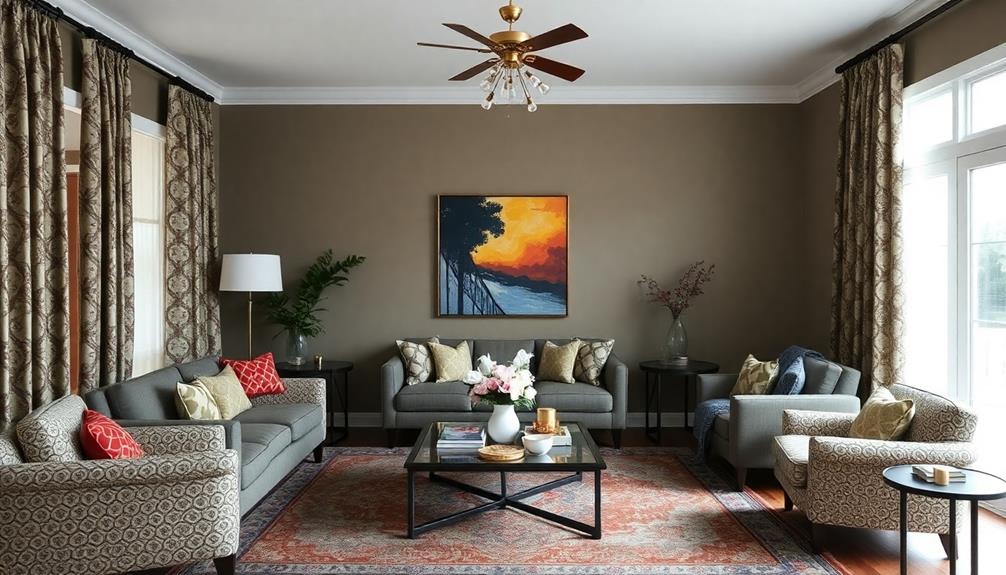
Avoiding over-matching decor is essential for creating a space that feels personal and inviting. When you use identical furniture sets, it can lead to a bland, uninspired look—think superstore vibes.
Instead, aim for a more customized look by mixing textures, tones, and shapes to enhance visual interest. Here are a few tips to help you break free from the matchy-matchy trap:
- Incorporate unique pieces: Collect items over time that reflect your personal style. This creates a curated feel in your space.
- Mix textures and patterns: Thoughtfully combine contrasting fabrics and shapes, like rounded pieces with traditional silhouettes, to add depth.
- Use color thoughtfully: Instead of sticking to a single color palette, introduce complementary hues that harmonize without being identical.
Frequently Asked Questions
What Is the Golden Rule in Interior Design?
The golden rule in interior design is balancing scale and proportion. You need to guarantee your furniture and decor sizes complement your space, preventing it from feeling overcrowded or sparsely furnished.
What Are the Do's and Don'ts of Interior Design?
Designing your space is like composing a symphony; balance is key. Do create functional layouts, mix lighting, choose fitting rugs, avoid clutter, and select art that complements your walls for a harmonious and inviting atmosphere.
What Problems Do Interior Decorators Solve?
Interior decorators solve problems like scale and proportion, lighting challenges, and color palette cohesion. They enhance furniture arrangement and artwork placement, ensuring your space feels balanced, inviting, and reflective of your personal style.
How Can I Make My Interior Look Better?
To make your interior look better, arrange furniture for flow, choose the right-sized rugs, hang artwork at eye level, mix lighting sources, and use a diverse color palette with various textures for visual interest.
Conclusion
Now that you're aware of these common interior decor mistakes, imagine stepping into a space that truly reflects your style. What if you could transform your home into a haven that feels both inviting and uniquely yours? Just think about the warmth of the right lighting, the perfect rug, and those personal touches that make all the difference. Don't let these simple errors hold you back—start making these changes today, and watch your space come alive! Maybe you’ve been craving a change in your home decor for a while now, but you weren’t sure where to start. Consider incorporating modern interior decor ideas, such as streamlined furniture, minimalistic artwork, and pops of color in unexpected places. By embracing these new concepts, you can revitalize your space and create a modern, stylish home that you’ll love coming back to every day. Don’t be afraid to take a leap and try something fresh and innovative in your home decor.
Home Decor
The Feng Shui Furniture Rule That Will Instantly Improve Your Space
Get ready to transform your space with the Feng Shui furniture rule that promotes harmony and flow—discover how to elevate your environment today!
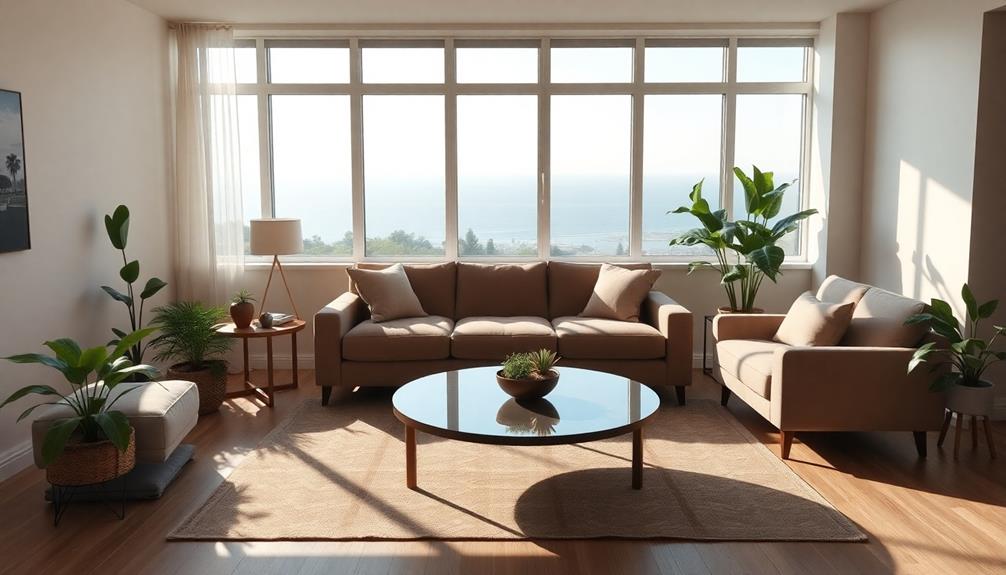
To instantly improve your space, position your furniture in the command position. This means placing key pieces like your bed or desk in a way that you can see the entrance while feeling supported by a solid wall behind you. Avoid pushing furniture against windows or corners to keep energy flowing. Make sure pathways are clear for easy movement. Adding natural elements, like plants, enhances this flow further. With a few tweaks, you can create a harmonious and inviting atmosphere. If you want to explore more ways to elevate your space, there's much more to discover!
Key Takeaways
- Position beds and desks in the command position to enhance energy flow and visibility of entrances for greater comfort and relaxation.
- Clear pathways and avoid clutter to facilitate movement, preventing energy stagnation and promoting tranquility within your space.
- Incorporate natural elements like plants to ground energy and refresh the atmosphere, enhancing vitality in your environment.
- Use soothing colors that resonate with you to influence mood and create a calming ambiance throughout your living space.
- Regularly reassess and update your furniture arrangement to align with personal growth, seasonal changes, and evolving preferences.
Understanding the Command Position

When you understand the command position, you can considerably enhance the flow of energy in your home. The command position refers to the strategic placement of furniture, particularly your bed and desk, allowing you to see the entrance while maintaining distance from direct sightlines. Incorporating elements like Indonesian decorative pillows can further enhance your space with their vibrant colors and intricate patterns, promoting a warm and inviting atmosphere. This setup fosters a sense of security and control, promoting relaxation.
In the bedroom, position your bed against a solid wall, ensuring you have visibility of the door while keeping pathways clear for ideal energy flow. This arrangement not only creates a peaceful sanctuary but also enhances your overall well-being.
In your living room, placing seating in a command position encourages conversation and interaction, enhancing the overall social atmosphere. Similarly, in your home office, position your desk to face the entrance, empowering you to feel aware of your surroundings while you work.
Avoid placing furniture against windows or crammed into corners, as this can disrupt energy flow and create feelings of vulnerability.
Balancing Energy Flow

Mastering the command position sets the foundation for a harmonious living space, but balancing energy flow takes it a step further. To truly enhance your environment, focus on furniture arrangements that create clear pathways and avoid clutter. This allows energy to circulate freely and prevents stagnation.
Consider the following elements to improve your space:
| Element | Importance |
|---|---|
| Clear Pathways | Promote movement and prevent obstruction. |
| Natural Elements | Incorporate plants for grounding energy. |
| Soothing Colors | Use soft tones to enhance tranquility. |
| Visibility of Front Door | Foster comfort and reduce anxiety. |
Position larger furniture pieces to encourage interaction while ensuring visibility of entrances. This not only nurtures a sense of security but also supports social connections. Regularly reassess your furniture arrangement and embrace seasonal decor changes to maintain ideal energy flow. By doing so, you'll create a clutter-free environment that radiates balance and tranquility, transforming your space into a calming sanctuary. Prioritizing these aspects of Feng Shui will elevate your living experience and promote a serene atmosphere for you and your guests. Incorporating feng shui furniture ideas can also inspire creative layouts that maximize both functionality and harmony within your space. Consider using round tables to encourage equality in conversations or placing mirrors strategically to reflect natural light and amplify positive energy. These thoughtful adjustments will further align your home with Feng Shui principles, enhancing its overall warmth and inviting ambiance.
Optimal Furniture Placement
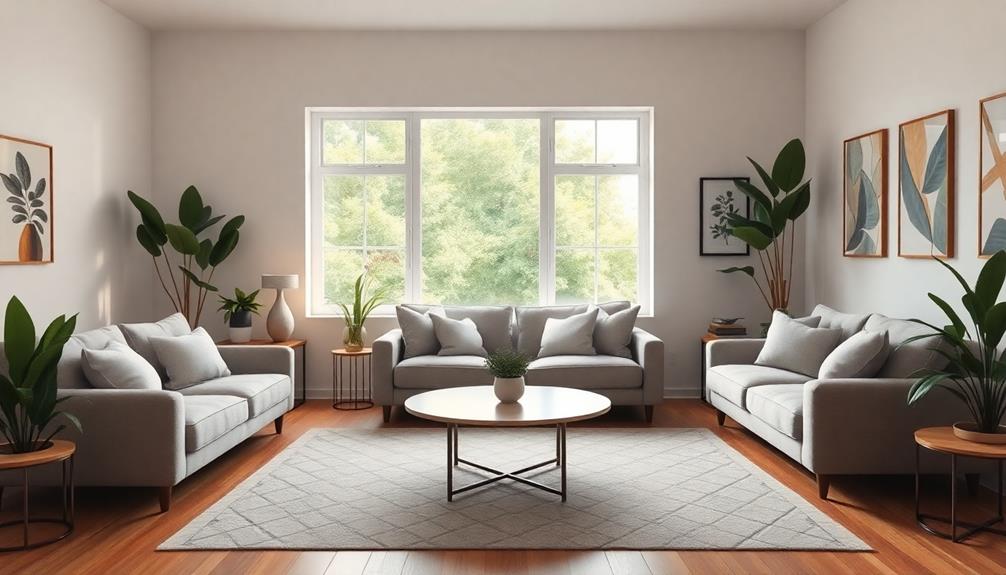
Optimal furniture placement is vital for creating a harmonious living space that promotes positive energy flow. To achieve ideal furniture placement, position larger pieces, like sofas, away from walls. This setup encourages an inviting atmosphere and facilitates conversation while ensuring you can see the front door for a sense of security.
Incorporating elements from Balinese design characteristics can further enhance the energy of your space by blending traditional craftsmanship with modern aesthetics. Avoid placing the back of the sofa against a window, as this blocks energy flow and may lead to feelings of instability.
Arrange seating to promote easy movement and interaction, keeping pathways clear to enhance overall energy. Incorporating natural elements, such as plants, can ground your space and elevate the energy. Place these near natural light sources for ideal growth, as they contribute to a vibrant environment.
Regular reassessments of your furniture arrangement are essential. By making seasonal adjustments, you can refresh your space, ensuring it continues to support your emotional well-being.
Always be open to tweaking your layout; sometimes, a simple shift can greatly enhance positive energy flow and create a more inviting atmosphere. Embrace these strategies to cultivate a space that nurtures both you and your guests.
Personalizing Your Space
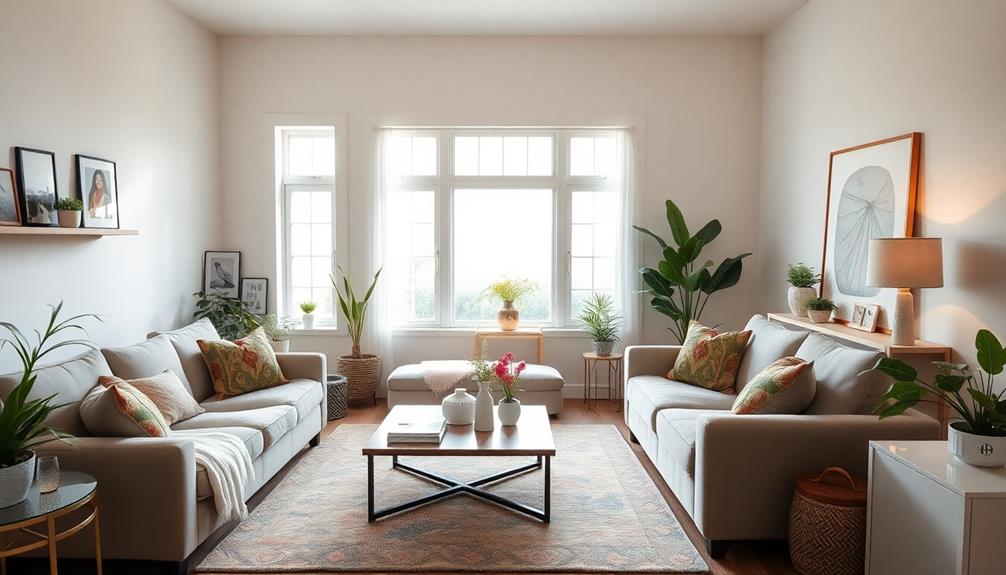
Personalizing your space transforms it into a reflection of who you are, making it feel more like home. Start by incorporating sentimental items like family photos or meaningful artwork, such as a unique Indonesian decor mask that represents rich cultural heritage. These pieces enhance your emotional connection to the space, fostering a sense of belonging.
Choose colors that resonate with you; they can greatly influence your mood and energy levels, promoting a calming atmosphere.
Don't forget to bring in natural elements such as plants and wood materials. These additions ground your space and provide a revitalizing connection to nature.
Regularly reassessing your decor allows you to reflect seasonal changes or personal growth, maintaining ideal energy flow and liveliness in your living area.
Thoughtful placement is key. Grouping objects in odd numbers can create visual appeal and elevate the overall harmony of the room.
Maintaining Harmony Over Time

Maintaining harmony in your space is essential for fostering a positive and inviting atmosphere. To guarantee your environment promotes ideal energy flow, regularly reassess your furniture arrangement. Seasonal changes often call for adjustments, so keep your space feeling fresh and welcoming.
| Action | Purpose |
|---|---|
| Declutter | Prevent stagnant energy |
| Incorporate | Utilize natural elements |
| Personal items | Evoke positive emotions |
| Schedule updates | Keep energy dynamic |
| Refresh energy | Create a calming atmosphere |
By decluttering consistently, you'll prevent stagnant energy, allowing tranquility to flourish. Incorporating natural elements like plants can further refresh energy, creating a calming atmosphere that nurtures your well-being. Don't forget to include personal items that evoke positive emotions, enhancing the overall harmony of your space.
Lastly, schedule periodic updates to your decor and furniture placement. This keeps your living space aligned with your evolving preferences and lifestyle. Embrace these practices to maintain harmony over time, guaranteeing your home remains a sanctuary that supports your journey to well-being.
Frequently Asked Questions
How to Feng Shui Your Space?
To feng shui your space, arrange furniture for clear pathways, promote conversation with seating, incorporate natural elements, use calming colors, declutter regularly, and strategically place mirrors to enhance light and energy flow.
How to Place Furniture According to Feng Shui?
Placing furniture's like arranging a dance; you want partners to face each other. Position your seating to encourage conversation, clear pathways for movement, and always guarantee a view of the door for security and comfort.
How Can I Improve My Room Feng Shui?
To improve your room's feng shui, position your bed for visibility of the door, declutter pathways, use soothing colors, add plants, and regularly reassess your arrangement for ideal energy flow and tranquility.
How Do You Arrange Furniture for Positive Energy?
To arrange furniture for positive energy, create clear pathways, position seating to face the door, encourage conversation with your layout, and incorporate natural elements. Regularly refresh arrangements to maintain an uplifting atmosphere in your space.
Conclusion
By following these feng shui principles, you can transform your space into a sanctuary that feels both inviting and balanced. Remember, it's all about creating harmony and flow. Have you considered how your furniture placement affects your daily energy? With a little mindfulness and personalization, you'll not only enhance your surroundings but also elevate your mood. Keep reassessing and adjusting as needed to maintain that perfect balance and guarantee your space continues to inspire you.
Home Decor
Why These 5 Feng Shui Principles Will Make Your Home Feel Complete
Transform your living space with these five Feng Shui principles that promise harmony and balance—discover how they can make your home feel truly complete.
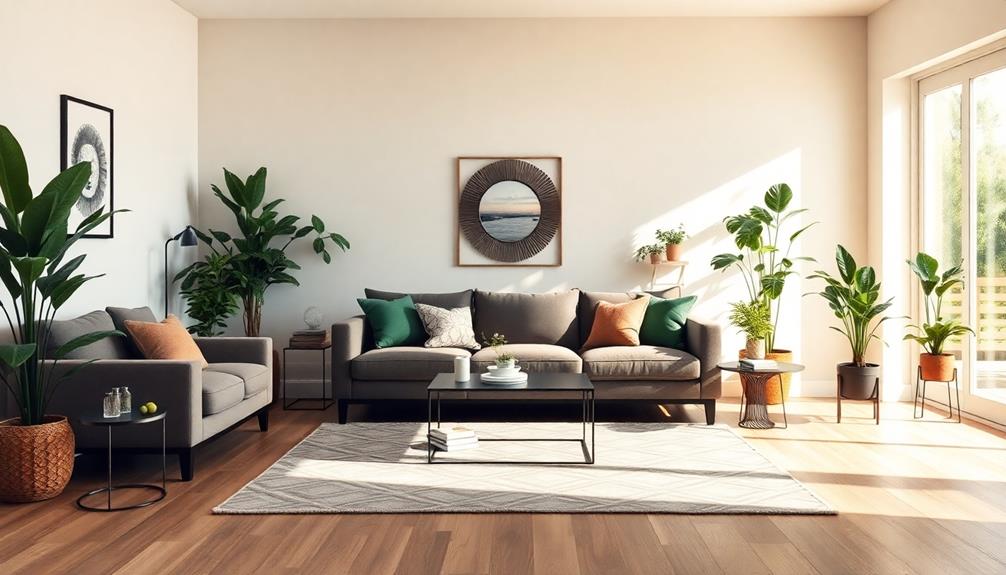
Incorporating these five Feng Shui principles can transform your home into a place of tranquility and balance. Start by decluttering to enhance energy flow and reduce stress, making your space feel inviting. Next, arrange your furniture strategically to promote good Chi and create functional zones. Thoughtful mirror placements can amplify light and positivity, while balancing the five elements in your decor fosters harmony and boosts relaxation. With these principles, you'll find your home feels complete and rejuvenating. Stick around to uncover even more ways to enhance your living space!
Key Takeaways
- Embracing Feng Shui principles enhances the flow of Chi, creating a lively and harmonious atmosphere in your home.
- Decluttering promotes positive energy circulation, reducing stress and chaos, leading to a more peaceful living space.
- Strategic furniture arrangement fosters an inviting environment, ensuring comfort and functionality in various areas of your home.
- Thoughtful use of mirrors boosts light and energy flow, reflecting positive elements and enhancing the overall ambiance.
- Balancing the five elements in design promotes relaxation and productivity, creating a sense of completeness and well-being in your home.
Understanding Feng Shui Principles
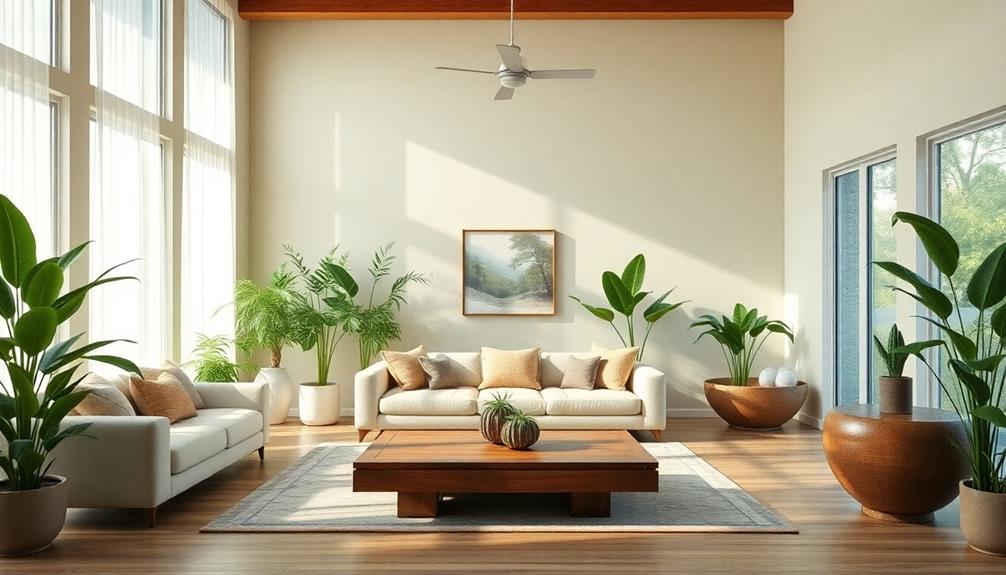
Feng Shui, an ancient Chinese practice, emphasizes the importance of energy flow, or Chi, in your living space. By understanding Feng Shui principles, you can create a balanced and harmonious environment that nurtures your well-being.
Central to this practice is the concept of Chi energy, which flows through your home, influencing your mood and liveliness. To enhance this flow of energy, consider incorporating elements of traditional Indonesian style home decor, which utilizes natural materials and emphasizes harmony with nature.
The Bagua Map serves as an essential tool, dividing your space into nine zones linked to different life aspects like wealth and health. Each zone can be activated by incorporating the five elements: Wood, Fire, Earth, Metal, and Water, ensuring a dynamic and organized space.
Feng Shui design also encourages the use of specific colors and materials to promote positive energy flow. For example, pink may attract love, while green can boost finances.
Additionally, integrating symbols like wind chimes or water features can further enhance the energy in your home.
Importance of Decluttering
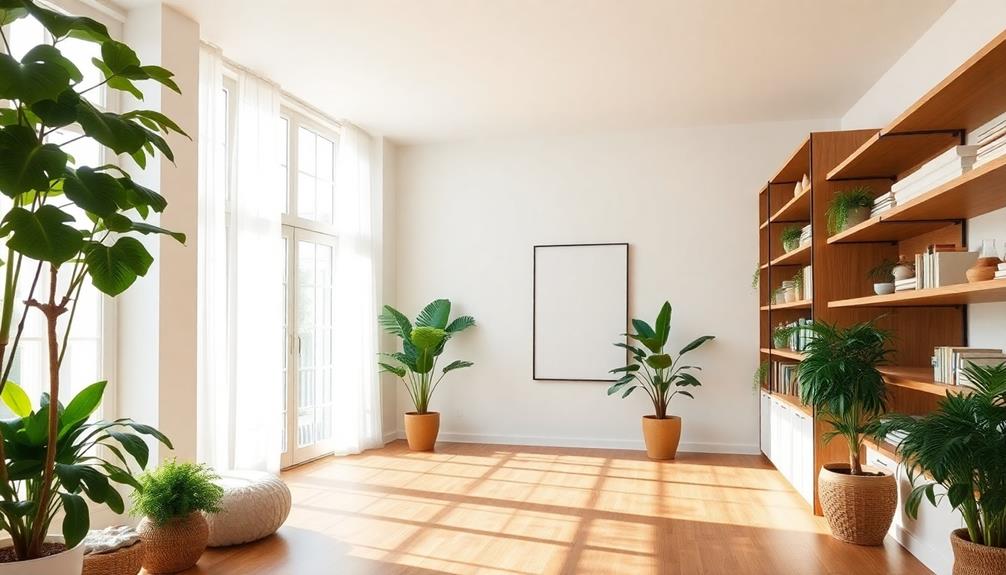
Decluttering is essential for maintaining a harmonious home, as it directly impacts the flow of chi, or energy, throughout your space. In Feng Shui, a clutter-free environment allows positive energy to circulate freely, enhancing your overall well-being. When you regularly declutter, you reduce chaos and stress, fostering mental clarity and emotional stability.
Here's how decluttering can transform your living space:
| Benefits of Decluttering | Effects on Well-being | Tips for Decluttering |
|---|---|---|
| Promotes positive energy | Reduces anxiety | Start small, focus on one area |
| Enhances relaxation | Improves sleep quality | Donate unused items regularly |
| Encourages creativity | Boosts mental clarity | Organize spaces effectively |
| Opens space for opportunities | Fosters emotional balance | Visualize your ideal space |
Strategic Furniture Arrangement

Arranging your furniture strategically can greatly enhance the flow of chi in your home, creating a more inviting and harmonious atmosphere. By positioning key pieces, like sofas and desks, to allow for clear visibility of entryways, you reduce feelings of vulnerability and boost comfort.
One essential element is placing your bed in a command position; ideally, it should face the door without being directly aligned with it. This arrangement promotes security and relaxation, crucial for restful sleep. Incorporating natural materials and earth tones, much like in Balinese interior design concepts, can further enhance the calming effect of your space.
Avoid sharp corners pointed toward seating areas, as they can foster discomfort and anxiety, disrupting your harmonious living space. Instead, utilize furniture to create distinct functional zones within a room. This encourages energy flow and supports various activities, enhancing the overall utility and vibe of your space.
Regularly reassessing your furniture placement can help maintain a balanced environment, allowing you to make adjustments that reflect your changing needs and preferences.
Thoughtful Use of Mirrors

Mirrors can be powerful tools in your home when used thoughtfully, enhancing both light and energy flow. In Feng Shui, the strategic placement of mirrors can greatly impact your living space.
For instance, incorporating elements like traditional artistry through vibrant Indonesian decor masks can complement the energy reflected by mirrors. Position them to reflect positive elements like plants or artwork, which amplifies good energy and promotes a sense of spaciousness.
Avoid placing mirrors directly facing beds or front doors, as this can lead to restlessness and energetic chaos. To maintain a peaceful environment, consider covering mirrors at night. This simple action helps mitigate any negative effects on your sleep, allowing for a more restful night.
Large mirrors can create the illusion of more space, but be cautious not to reflect clutter or negative imagery, as this can disrupt harmony in your home. Regularly evaluate your mirror placements to verify they support the desired energy flow and atmosphere in each room.
An organized approach to mirrors not only reflects your style but also contributes to a serene atmosphere, fostering positive energy throughout your home. Thoughtful use of mirrors can transform your space, making it feel complete and inviting.
Balancing Elements in Design
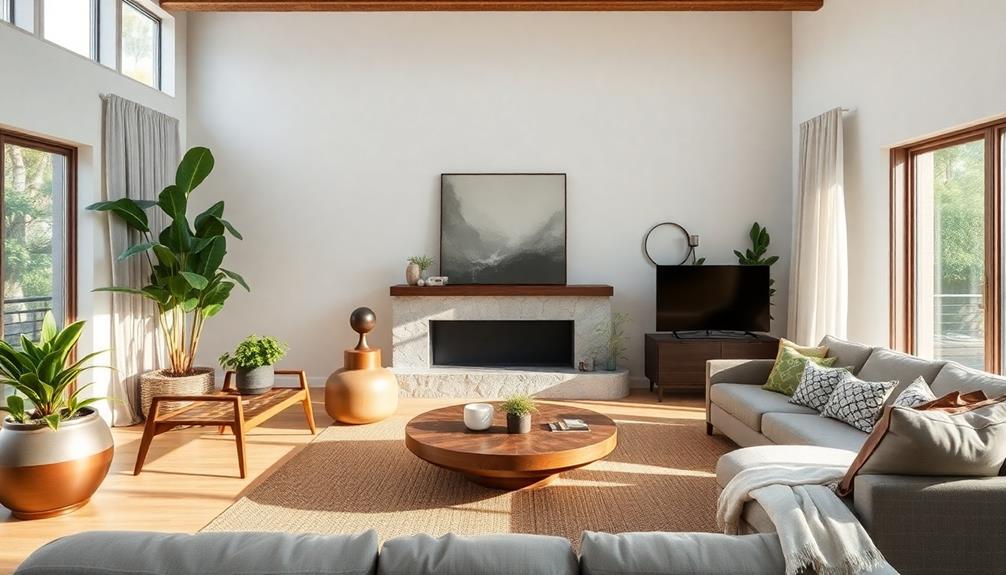
How can you create a harmonious environment in your home? Balancing the five elements—wood, fire, earth, metal, and water—is crucial for enhancing energy flow and promoting relaxation. Each element influences mood and energy, so incorporating them thoughtfully in your home design can greatly improve the quality of your space.
For example, vibrant colors and intricate patterns found in Indonesian decorative pillows can enhance the wood element, evoking feelings of growth and liveliness, while metal accents can provide clarity and structure. Understanding how these elements interact helps you avoid deficiencies; adding water features or blue decor can counteract excessive fire energy, ensuring balance and harmony throughout your home.
Utilizing Feng Shui principles, a chart can guide you in identifying which elements are lacking in your space. This way, you can make informed design choices that foster emotional and physical well-being.
Aiming for a balanced element composition not only enhances your home's aesthetic appeal but also creates a peaceful and calming atmosphere, boosting relaxation and productivity. With these adjustments, you'll cultivate a harmonious environment that resonates with positive energy and tranquility.
Frequently Asked Questions
What Are the 5 Principles of Feng Shui?
The five principles of Feng Shui are Chi Flow, Yin and Yang, the Five Elements, Clutter Clearing, and the Bagua Map. Each principle helps you create a balanced, harmonious, and energetically supportive home environment.
What Are the 5 Elements of Feng Shui?
The five elements of Feng Shui are Wood, Fire, Earth, Metal, and Water. Each element represents unique qualities and energies that influence your space and well-being, guiding you to create a harmonious environment.
How to Use Feng Shui in Your Home?
Transforming your home into a sanctuary could feel like magic! You can use feng shui by decluttering, arranging furniture wisely, adding natural elements, choosing soft colors, and enhancing lighting to create a harmonious, inviting space. Incorporating a feng shui color palette can further elevate the energy in your home, promoting balance and positivity. Opt for soothing hues like gentle greens, calming blues, or warm earth tones to foster a sense of peace and well-being. These thoughtful design choices not only enhance the visual appeal of your space but also nurture your emotional and spiritual connection to your environment.
How Important Is Feng Shui in a House?
Feng Shui's essential for your house because it optimizes energy flow, creating a balanced environment. When you embrace its principles, you enhance your well-being, promote relaxation, and foster a sense of harmony in your space.
Conclusion
By applying these five feng shui principles, you can create a harmonious space that feels complete and inviting. Decluttering not only clears physical space but also promotes mental clarity. When you arrange furniture thoughtfully and use mirrors strategically, you enhance energy flow. Balancing the five elements in your design fosters a sense of equilibrium. While some may debate the scientific basis of feng shui, many find that its practices enhance well-being, proving that intention can shape our environments profoundly.
Home Decor
The Ultimate Guide to Using Feng Shui for Maximum Peace in Your Space
Journey into the world of Feng Shui and discover secrets to transform your space into a serene sanctuary that enhances your well-being.

To achieve maximum peace in your space through Feng Shui, focus on creating a harmonious energy flow. Start by decluttering to allow Chi to circulate freely. Incorporate the five elements—Wood, Fire, Earth, Metal, Water—to balance your environment. Use the Bagua map to enhance specific life areas, and strategically place soft lighting and plants for tranquility. Choose calming colors and arrange your furniture to facilitate connection. Remember, your space should reflect your personality and intentions to amplify positive energy. This guide can reveal more techniques to guarantee your environment fosters a peaceful atmosphere conducive to well-being. Don’t forget to pay attention to your entryway, as it serves as the gateway for energy entering your home; keeping it clean and inviting is essential. Mirrors can be another powerful tool to amplify light and energy, but be mindful of their placement to avoid reflecting negative vibes. By taking these small but impactful steps to feng shui your living space, you can create a sanctuary that nurtures balance, calmness, and positivity in your daily life.
Key Takeaways
- Create a harmonious flow of energy (Chi) by decluttering and organizing your space regularly to promote positivity and tranquility.
- Utilize the Bagua map to identify and enhance specific life areas, aligning your space with your personal goals.
- Incorporate natural elements like plants and water features to elevate energy flow and foster a calming atmosphere.
- Use soft, neutral color palettes and strategic lighting to create a relaxing environment that promotes peace and comfort.
- Position furniture thoughtfully in each room, ensuring clear pathways and a commanding placement for restful energy and productivity.
Understanding Feng Shui Principles
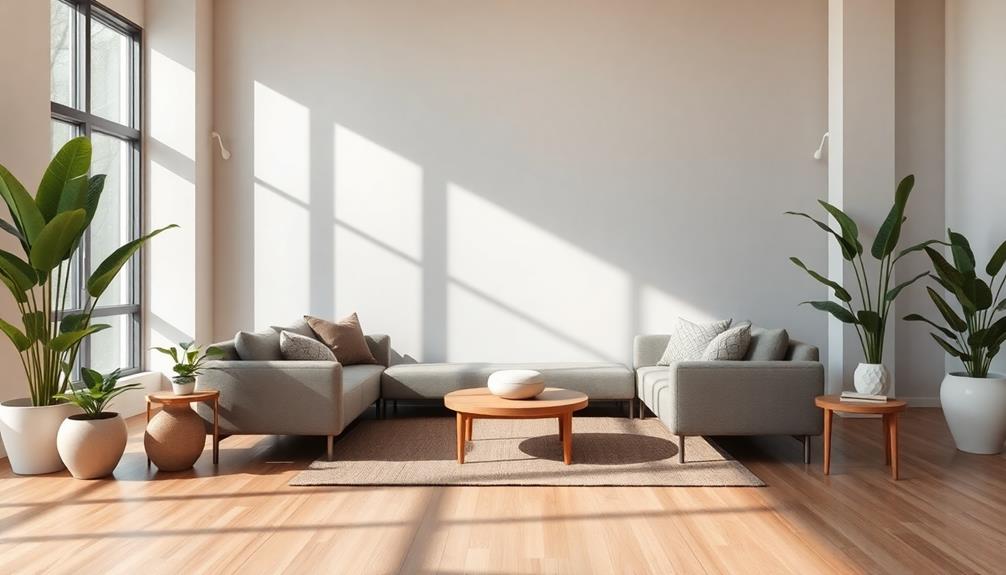
Feng Shui is all about creating a harmonious flow of energy, or Chi, within your space. By understanding the core Feng Shui principles, you can enhance your well-being and invite positive energy into your life.
Central to this practice is the balance of Yin and Yang, which represents passive and active energies respectively. This balance is essential for ensuring that your environment feels harmonious and supportive. You can enhance your space further using elements of Indonesian decorative pillows that add vibrant colors and intricate patterns, promoting comfort and cultural richness.
You can incorporate the five elements—Wood, Fire, Earth, Metal, and Water—into your space to further influence the flow of energy. Each element corresponds to specific colors and shapes, allowing you to tailor your environment to promote desired outcomes, whether it's prosperity, health, or relationships.
Utilizing the Bagua map can help you identify which areas of your life you want to enhance. By dividing your space into nine life areas, you can strategically arrange furniture and decor to amplify energy in those specific zones.
Key Feng Shui Tools and Symbols
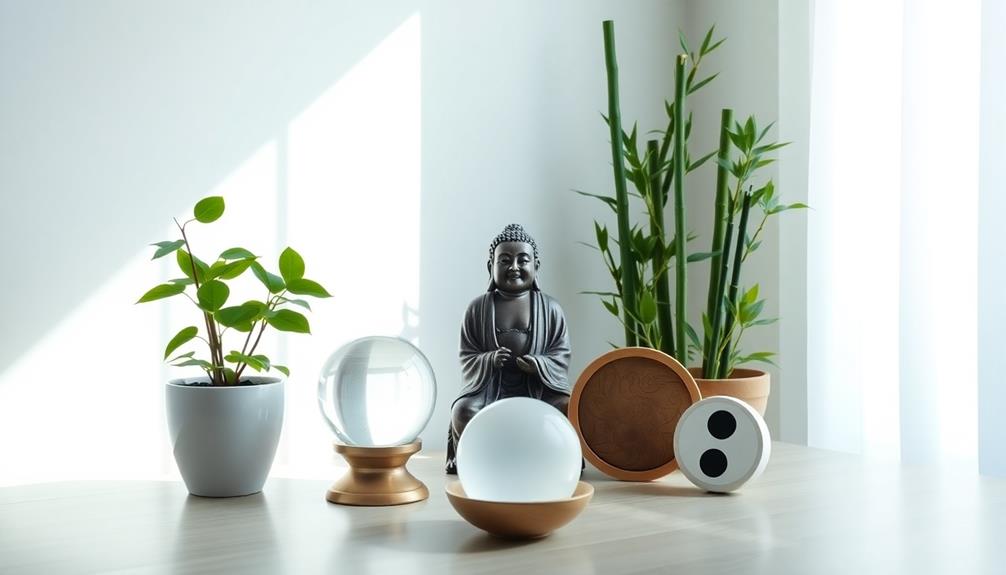
To create harmony in your space, you'll want to explore the Bagua Map and the significance of Celestial Animals.
Incorporating elements such as traditional artistry can enhance the energy flow, while vibrant decorations may uplift your spirits and promote positivity.
The Bagua Map helps you identify areas of your life that need attention and improvement, while the Celestial Animals symbolize guidance and support in various aspects.
Understanding these tools can enhance the energy flow in your environment, leading to greater peace and balance.
Celestial Animals Overview
In the world of Feng Shui, celestial animals serve as powerful symbols, each one embodying unique energies that can influence various aspects of your life. The Green Dragon, representing your career, is associated with the east and promotes growth and liveliness. To harness its energy, consider incorporating its image in your workspace.
Additionally, you can enhance the workspace's ambiance by using natural materials and earth tones, reflecting the calming effects of Balinese design principles. The White Tiger, linked to relationships, symbolizes strength and protection and is connected to the west. Displaying this symbol can help create balanced and harmonious interactions with others.
For health, the Black Tortoise is your ally, representing stability and support. Found in the north, its energy can enhance your well-being when included in your living space.
Finally, the Red Phoenix, representing wealth and fame, is connected to the south and encourages recognition and prosperity. By integrating these celestial animals into your environment, you can focus on enhancing specific life areas.
Understanding these symbols allows you to tap into their energies effectively. By consciously placing representations of these celestial animals around you, you can cultivate a more balanced and harmonious life.
Embrace their unique qualities to transform your space and invite positive changes.
Bagua Map Explained
The Bagua Map is an essential tool for anyone looking to enhance the energy in their space. This powerful Feng Shui tool divides your environment into nine areas, each linked to different aspects of life, such as Wealth, Love, and Career. By using the Bagua map, you can target specific areas to boost positive energy in your home or office.
Incorporating elements of traditional Indonesian style home decor can further enhance the harmony and tranquility of your space, using natural materials and intricate designs that resonate with nature.
To apply the Bagua map, align it with the main entrance of your space. Each section will correspond to the areas of life it represents, making it easier for you to adjust your decor accordingly. For instance, the Wealth area is often associated with the color purple and the Wood element. By incorporating these colors, shapes, and symbols, you can amplify positive energy and improve your financial situation.
You don't need a large space to benefit from the Bagua map; even small adjustments can greatly enhance energy flow without extensive renovations.
Whether you're a renter or simply want to refresh your space, using these Feng Shui techniques can help you create a harmonious environment that nurtures all aspects of your life.
Essential Feng Shui Dos and Don'ts
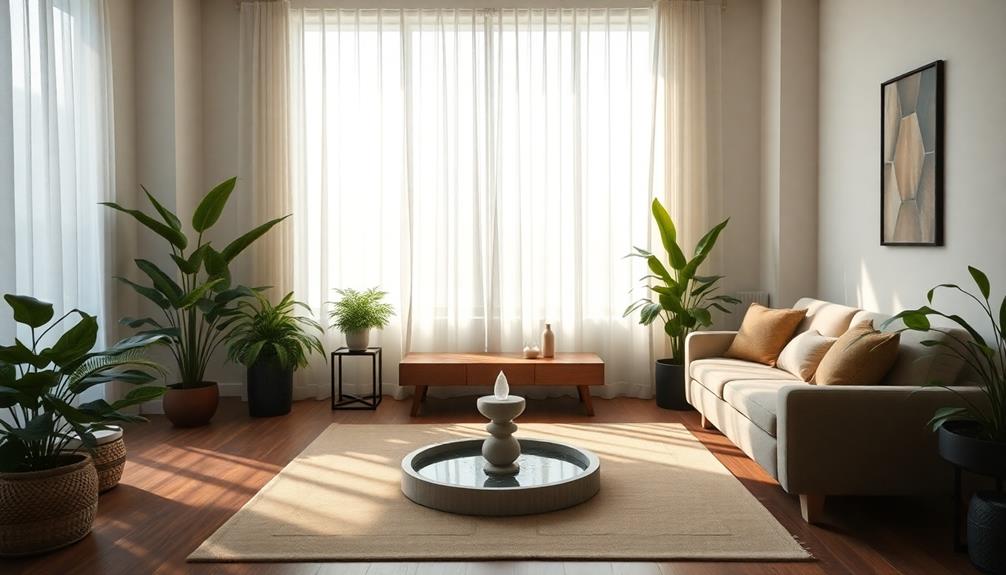
Creating a harmonious living space requires attention to certain Feng Shui principles that can greatly impact your well-being. To start, you should declutter regularly. Clutter blocks Chi, the life force energy, and creates chaos in your environment, so keeping your space tidy is essential for maintaining positive energy flow.
Incorporating elements of cultural decor, such as Indonesian decor masks, can also enhance the aesthetic appeal and storytelling aspect of your space, enriching the overall ambiance.
Incorporating soft, calming colors like neutrals and pastels can enhance relaxation. Avoid overwhelming bright colors, as they can induce stress.
Another effective Feng Shui tip is to bring in plants. They improve air quality and enhance vigor, contributing to a harmonious atmosphere.
On the flip side, don't place furniture in a way that blocks pathways or doors. This restriction hinders energy movement and can lead to stagnant energy, which you definitely want to avoid.
Additionally, don't ignore broken items in your space. They symbolize stagnation and can hinder your progress. By repairing or removing these items, you open the door for new opportunities.
Room-Specific Feng Shui Guidelines

Every room in your home has its own unique energy, and applying Feng Shui principles can amplify that vibe.
Start by arranging your living room furniture to create a welcoming flow, ensuring seating allows for a clear view of the entrance, promoting safety and comfort.
In the kitchen, keep the stove and sink clean, as they symbolize nourishment; clutter can block the flow of positive Chi.
For the bathroom, maintain cleanliness and privacy by keeping the toilet lid closed and the door shut. Adding plants purifies the air and balances water energy.
In your bedroom, position the bed in a commanding position facing the door, allowing for space on both sides, and use calming colors to foster restful sleep.
Finally, in your office, place your desk in a commanding position to boost productivity and creativity, while keeping the workspace clutter-free for the free flow of ideas and energy.
- Arrange furniture for welcoming flow
- Keep kitchen spaces clean and organized
- Maintain bathroom privacy and cleanliness
- Position bed for restful sleep
- Place desk to encourage productivity
Enhancing Energy Flow
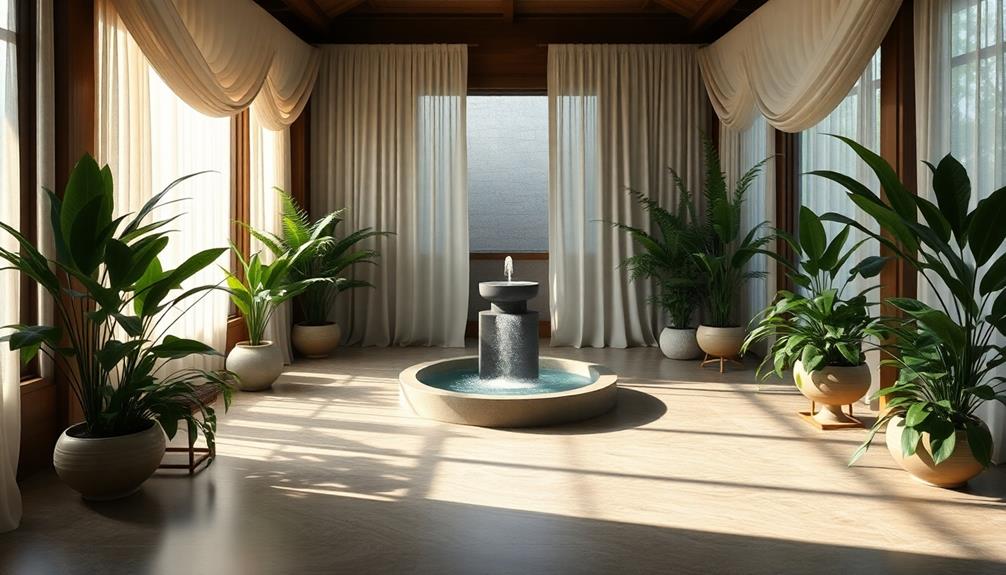
To enhance energy flow in your home, focus on keeping pathways clear and decluttering regularly. This practice guarantees a smooth flow of Chi energy, promoting peace and tranquility.
Start by evaluating each room; remove any items that don't serve a purpose or bring you joy. Additionally, consider incorporating elements from luxury tropical designs that blend natural beauty with modern aesthetics, which can elevate the overall harmony of your space.
Incorporating natural elements like plants and water features can markedly enhance energy flow. These elements are tied to liveliness and abundance in Feng Shui, so consider adding a small fountain or potted plants to your space.
Soft, warm lighting also plays an essential role. Utilize strategic lighting and mirrors to reflect and amplify positive energy, making your environment feel more open and inviting.
Don't forget to regularly refresh your surroundings. Rearranging furniture and decor stimulates energy movement, preventing stagnation and enhancing harmony.
An organized space not only supports energy flow but fosters a calming atmosphere conducive to relaxation and well-being.
Creating a Calming Home Environment
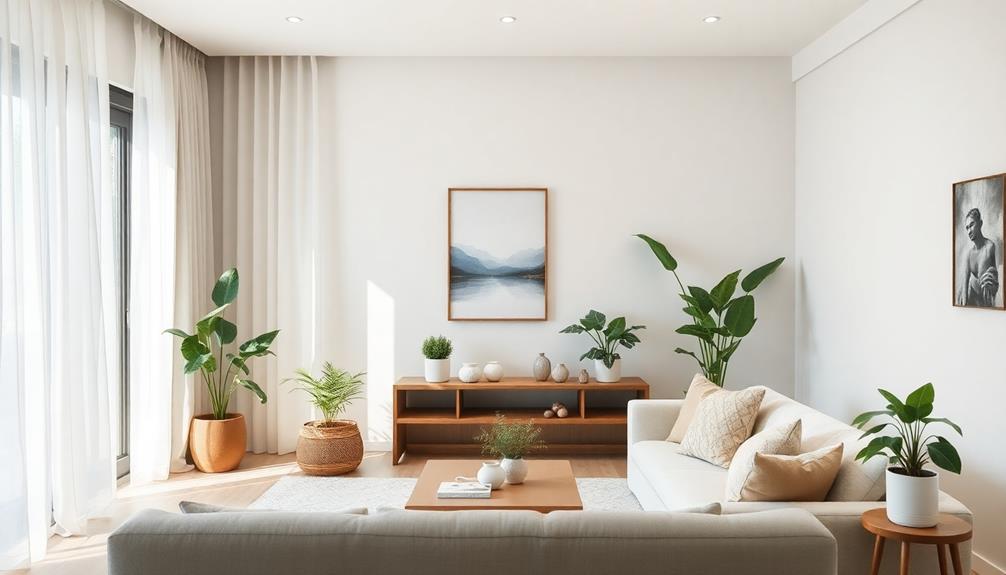
To create a calming home environment, start by choosing a soft color palette that includes soothing shades like light blues and greens.
This choice not only promotes relaxation but also enhances the overall atmosphere of your space.
Consider incorporating elements of tropical villa plans that emphasize open spaces and natural light to further cultivate serenity.
Pair these colors with strategic lighting, using warm lights and dimmers to foster a comforting ambiance that invites peace and tranquility.
Soft Color Palette
Choosing a soft color palette can transform your living space into a sanctuary of peace and relaxation. By incorporating neutral hues like soft whites, gentle beiges, and light pastels, you'll create a peaceful and calming atmosphere that aligns with Feng Shui principles.
Colors such as light blue and pale green are perfect for bedrooms and meditation areas, promoting restful energy essential for rejuvenation. Additionally, embracing traditional Indonesian housing aesthetics can inspire your color choices, as they often utilize local materials and soothing tones to create harmony with the environment.
To enhance the calming energy in your home, consider these ideas:
- Use soft browns and muted yellows to evoke a grounding atmosphere.
- Opt for shades that create serenity, avoiding overwhelming bright colors.
- Choose a monochromatic scheme or analogous colors for visual cohesion.
- Incorporate Earth element colors for stability and nourishment.
- Keep decor minimalistic to maintain a sense of order.
Strategic Lighting Placement
Strategic lighting placement plays an important role in creating a calming home environment. By using soft, warm lighting, you can greatly enhance comfort and relaxation in your space. Consider installing dimmer switches to adjust lighting levels based on the time of day and your mood. This flexibility helps foster a serene ambiance crucial for maintaining positive Chi.
Additionally, incorporating elements of Indonesian wedding decor can inspire unique lighting designs that reflect cultural richness and warmth.
Incorporate natural light by maximizing windows and reflective surfaces, which not only elevate your energy levels but also promote a sense of openness and connection to nature. This connection is essential for your overall well-being.
Position your lights to illuminate key areas like reading nooks or artwork, establishing focal points that draw the eye and create balance within the room.
Layered lighting is another effective strategy. By combining ambient, task, and accent lighting, you guarantee a harmonious balance that adapts to various activities and needs. This approach contributes to a more peaceful home environment, allowing you to feel more at ease.
Benefits of a Peaceful Space
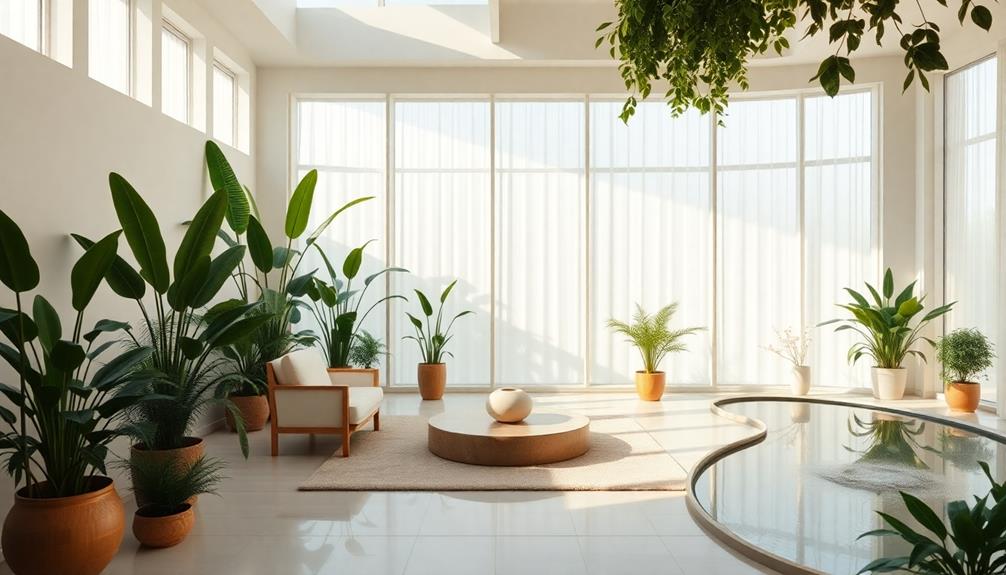
Creating a peaceful space offers numerous benefits that can markedly enhance your daily life. When you cultivate an environment focused on tranquility, you'll experience improved mental clarity and the ability to concentrate on tasks without distractions.
Incorporating elements such as an Indonesian decor mask can also add a unique cultural touch to your space, enriching the ambiance and promoting appreciation for traditional craftsmanship. Research shows that calming surroundings can elevate your mood and emotional stability, leading to greater overall well-being.
Here are some key benefits of a peaceful space:
- Enhanced focus: Better concentration on tasks and projects.
- Improved mood: A serene environment can boost your emotional health.
- Restful sleep: A well-organized space encourages relaxation and recovery.
- Life satisfaction: Thoughtful design fosters healthy relationships and a sense of belonging.
- Reduced stress: Decluttering creates a tidy environment, allowing you to recharge effectively.
Personalizing Your Feng Shui Approach
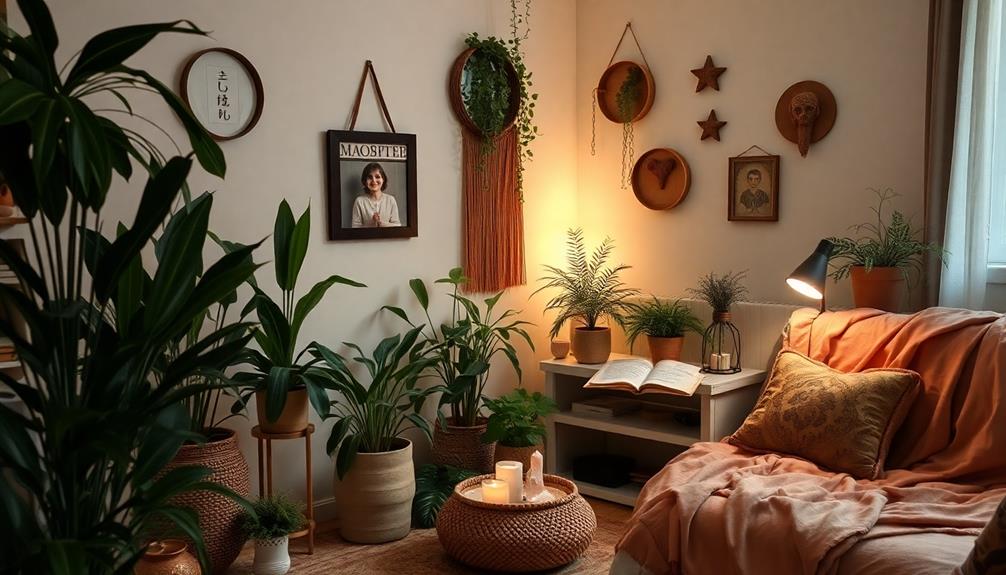
Personalizing your Feng Shui approach can transform your space into a true reflection of your unique energy and aspirations.
Start by determining your Kua number, which you can calculate using your birth date and gender. This number reveals your lucky directions, essential for enhancing your personal energy.
Next, incorporate meaningful objects and colors that resonate with you. Focus on specific hues linked to the five elements—wood, fire, earth, metal, and water—to amplify positive energy.
Arrange your furniture and decor to align with your lucky direction, creating an environment that supports your goals.
Utilize the Bagua map to pinpoint areas of your life you wish to enhance, like career or love.
Personalize those spaces with elements that resonate with your intentions.
Frequently Asked Questions
How Long Does It Take to Feel Feng Shui Effects?
You might start feeling the effects of feng shui within a few days, but significant changes often take weeks to manifest. It really depends on your space and how consistently you apply the principles.
Can Feng Shui Improve Relationships in My Home?
Yes, feng shui can improve relationships in your home. By arranging your space thoughtfully and removing clutter, you create an environment that fosters connection, harmony, and positive energy, which can enhance your interactions with loved ones.
Is It Necessary to Hire a Feng Shui Expert?
Just like a skilled conductor brings harmony to an orchestra, hiring a feng shui expert can enhance your space's energy. However, if you're willing to learn, you can also apply principles yourself and achieve balance.
What Should I Do if I Can't Rearrange Furniture?
If you can't rearrange furniture, focus on decluttering and adding plants or mirrors to enhance energy flow. You can also change decor colors or use specific items to create balance and harmony in your space.
Can I Use Feng Shui Principles in My Garden?
Studies show that green spaces can reduce stress by up to 30%. You can apply feng shui principles in your garden by creating balance, using natural elements, and ensuring a harmonious flow of energy.
Conclusion
In a world filled with chaos, your home can be a sanctuary of peace. By embracing feng shui principles and making simple adjustments, you can transform your space from overwhelming to tranquil. Imagine stepping into a room that radiates calm instead of clutter. With personal touches and mindful choices, you'll not only enhance your environment but also nurture your well-being. Don't just live in your space—let it support and uplift you. Your peaceful retreat awaits!
-

 Mom5 months ago
Mom5 months agoHeartfelt Poems for Your Daughter’s Birthday
-

 Mom5 months ago
Mom5 months agoHappy Birthday Religious Wishes and Blessings
-

 Mom5 months ago
Mom5 months agoHappy 65th Birthday: Celebrate Your Special Day!
-

 Mom5 months ago
Mom5 months agoHappy Birthday in Heaven from Daughter: Remembering You
-

 Mom5 months ago
Mom5 months ago62nd Birthday Quotes for Mom: Celebrate Her Special Day
-

 Mom5 months ago
Mom5 months agoCelebrating 60 Years: Happy 60th Birthday Wishes
-

 Special Occasions4 months ago
Special Occasions4 months agoUplifting Words: Inspirational Church Anniversary Messages!
-

 Mom5 months ago
Mom5 months agoCelebrate a Joyous Happy 70th Birthday Milestone!

















